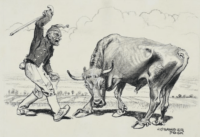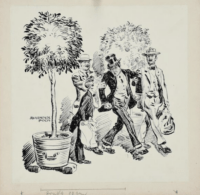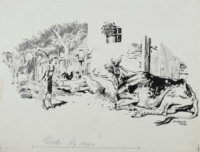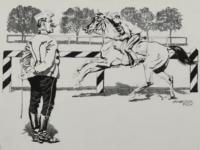Alexander Pock
Alexander Pock (*6 January 1871 in Znojmo, Moravia; †19 November 1950 in Vienna) was an Austrian painter who specialized in military, genre and portrait motifs and became known above all for his detailed depictions of the Austro-Hungarian army. Army.
Born the second of seven children in a wealthy family in Znojmo, Pock showed artistic talent at an early age, which was encouraged by his father. After leaving grammar school, he moved to Vienna in 1886 to study at the Vienna Academy under Christian Griepenkerl and Carl Rudolf Huber. He developed a particular fascination for military subjects, especially the hussars, dragoons and Uhlans of the colorful Imperial and Royal Army. army. His talent for depicting horses soon caught the eye of Archduke Franz Ferdinand, who supported Pock as a patron and client. Pock’s studio was located in the dome of Vienna’s Palais Equitable, which enabled him to present his works to a high-ranking audience.
In 1892, Pock joined the k.u.k. Infantry Regiment No. 99 “George I, King of the Hellenes” as a one-year volunteer and served until 1899, finally as a lieutenant in the reserve. After his time in the army, he traveled to art metropolises such as Florence, Rome and Munich to study the Old Masters. Back in Vienna, he quickly gained a reputation as an outstanding military painter, thanks in part to his naturalistic style of painting, and his works were appreciated by aristocrats and bourgeois circles alike. He also cultivated close ties with the Dreher family, who were renowned for their horse breeding in Hungary, and became a portrait painter of their noble horses.
Pock also worked as an illustrator, including for school and youth books and for the Meggendorfer-Blätter, and taught at the Staatsgewerbeschule in Vienna. His meticulously accurate, often almost documentary-like paintings are considered valuable testimonies to imperial and royal military history. military history. Pock always remained true to his naturalistic style and concentrated on a factual, detailed depiction. He usually created his works through elaborate preliminary studies, including sketches and oil studies, which made his painting style appear calm and academic, without the dynamism of impressionist influences.
Although he occasionally received criticism for his realistic style, Pock’s accurate and colorful painting style was appreciated by connoisseurs, especially for its precise rendering of the uniforms of the old Austrian army. He preferred canvas, but also used cardboard due to wartime shortages. With his rather thin application of paint, he kept the motifs sober, without conspicuous brushstrokes. This made him a formative chronicler of his time and a respected military painter in Austria.
Showing all 5 resultsSorted by latest
-
Rind gegen alten Mann | Federzeichnung von Alexander Pock; Meggendorfer Blätter
Alexander Pock (1871-1950)
Medium beschädigt mit Rissen -
Abgeführter Mann | Federzeichnung von Alexander Pock; Meggendorfer Blätter
Alexander Pock (1871-1950)
Medium beschädigt mit Rissen -
Kind und Rinder | Federzeichnung von Alexander Pock; Meggendorfer Blätter
Alexander Pock (1871-1950)
Medium beschädigt mit Rissen -
Mann mit Rind | Federzeichnung von Alexander Pock; Meggendorfer Blätter
Alexander Pock (1871-1950)
Medium beschädigt mit Rissen -
Reitstunde | Federzeichnung von Alexander Pock; Meggendorfer Blätter
Alexander Pock (1871-1950)
Medium beschädigt mit Rissen





